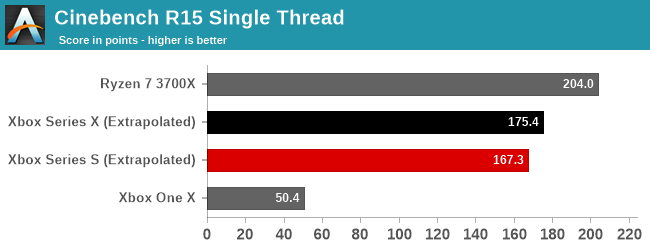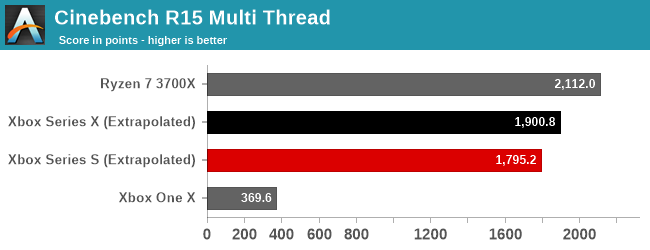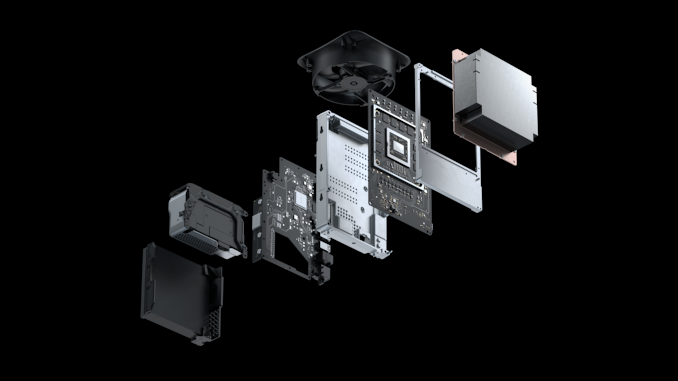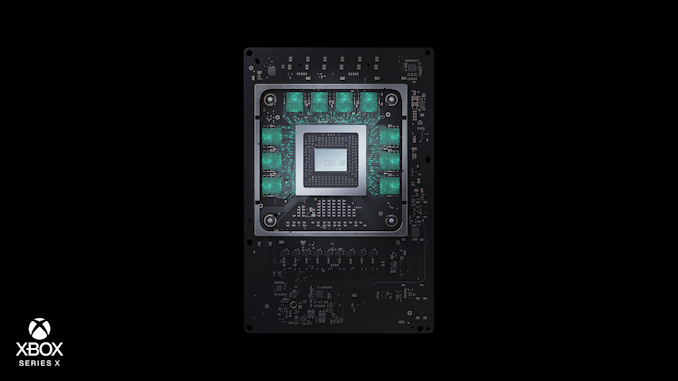The Xbox Series X Review: Ushering In The Next Generation of Game Consoles
by Brett Howse on November 5, 2020 9:00 AM ESTPowering Xbox: All AMD
Anyone watching the PC space should be aware of how far AMD has come in the last couple of years. First with the launch of their Zen CPU architecture, and again with Zen 2 and Zen 3, AMD has shot back up to being a formidable opponent for Intel. On the graphics side, AMD has trailed market leader NVIDIA for some time, although they are trying to make amends with their new RDNA 2 graphics architecture. Throughout all of this, AMD has been a staple in the console space, providing the system on a chip (SoC) powering both PlayStation and Xbox in the last generation, and AMD’s design wins have continued for this new generation.
Harnessing Zen 2
The big difference for this generation of console is just how far AMD has come with their CPU architecture. The Xbox One and its various revisions were powered eight AMD Jaguar CPU cores, at 1.75 GHz in the Xbox One and One S, and 2.3 GHz in the One X. Originally designed for small, low-power (and low-cost) systems, Jaguar was not the best CPU architecture when it launched. And following the years since then serving as the heart of the last generation of consoles, Jaguar is definitely feeling the pinch in 2020.
For the Xbox Series X|S lineup, Microsoft is again turning to AMD, and this time AMD is ready and waiting for Microsoft with their much more powerful Zen 2 CPU cores. In the case of the Xbox Series X, it is offering eight cores which will run at 3.8 GHz sustained on eight threads, or if the developer chooses to leverage Simultaneous Multithreading (SMT) and run sixteen threads, the processor will run at 3.6 GHz sustained. The lower-powered Series S offers the same number of cores, but at 3.6 GHz / 3.4 GHz instead. Some may wonder why they do not match the 4 GHz+ frequencies of the desktop counterparts, but consoles are more about consistent experiences than peak performance for a short time, so there is no turbo function in the Xbox.
To highlight just how great the difference in performance is between the old Jaguar cores and AMD's Zen 2 cores, we'll start with a quick look at Cinebnech R15. We have been lucky enough to actually benchmark the Xbox One SoC, with eight Jaguar cores running at 2.3 GHz, matching the CPU frequency of the Xbox One X. Unfortunately, there is no exact replica of a Zen 2 processor to compare, but the Ryzen 7 3700X we tested offers the same eight cores and sixteen threads, although with a 4.4 GHz turbo frequency. So we'll go ahead and extrapolate from the score for AMD's Ryzen 7 3700X CPU to account for the slower clockspeeds of the new Xboxes,


XSX/XSS: Performance Extrapolated From R7 3700X
Even adjusted to somewhat match the lower clockspeeds of the new consoles, the raw performance from the new Zen 2 processor in the Series X is significantly higher than the outgoing Xbox One X. Under Cinebench R15, single-threaded performance is an impressive 248% faster in the Series X, and 232% in the Series S. With up to 16 threads available on the new consoles, multithreaded performance offers an even larger benefit, at 414% faster in the Series X, and 386% faster in the Series S.
The previous generation consoles were significantly CPU limited, and while this was not always noticeable in gameplay, the new generation should be able to offer much more immersive scenes with more going on at any one time thanks to the major CPU performance increase – even on Series S.
Powered by RDNA 2
Of course, a major part of any console is the graphics processing unit. And even more so than on the CPU side, Microsoft's choice of architecture for the GPU side of their console SoCs is on the absolute cutting edge thanks to AMD's RDNA 2 architecture. In fact, at launch, the Xbox Series X will have a more modern AMD GPU than is available in any PC since AMD is not releasing RDNA 2 to the PC until 8 days after the console launch. RDNA 2 brings about some major upgrades to AMD’s GPU lineup which the Xbox team will leverage to get the most out of the new hardware.
One of the biggest changes is the inclusion of hardware support for ray tracing, and as Microsoft has implemented DirectX Ray Tracing (DXR) support, the hardware and software will finally be available in a console for developers to leverage ray tracing for scene lighting. It will no doubt come at a performance penalty, as it is still a massively complex and computationally expensive task to use ray tracing for lighting, but for games that can handle the performance loss, the quality of the lighting, reflections, and other effects should increase tremendously.
Not to be outdone, shaders have also seen some tremendous improvements with this generation, and the Xbox is taking advantage of all the improvements. Mesh shaders allow highly complex scenes to be rendered by having threads cooperate, so thousands of geometric objects can be shaded from a relatively low number of shaders. Imagine a beach where every grain of sand needs to be rendered. Since most of the grains of sand are similar, mesh shading allows for a significant amount of replication to be avoided, without taking away from the overall image quality. There is a lot more to mesh shaders than just this example, and they will require new game engines to take advantage of the new shader processes, but we should start to see this in next-gen titles in the future.
RDNA 2 also brings Variable Rate Shading (VRS) to the table, which allows developers to concentrate their resources where it is important. In any one scene, not all of the image display is going to be noticed, so VRS allows the developer to focus the performance and image quality on the parts of the scene that are the most important by reducing the shading quality in those unimportant areas. This allows for higher frame rates, ideally without a noticeable impact on visuals. We are seeing this already implemented at launch in games optimixed for the X|S lineup, such as Gears 5.
Adding to the new hardware features is the varying sizes of the integrated GPUs inside of the Xbox Series X|S. On the CPU side, the consoles are similar in hardware, but on the GPU and other fronts, the Series S and Series X most definitely diverge. The GPU is certainly one of the most obvious changes here, as Microsoft has outfitted the Series X with a beefy 12 TFLOP GPU, with 52 CUs, and a 1.825 GHz frequency. This is slightly smaller than the Radeon RX 6800 announced at the end of October but still double the TFLOPS of the Xbox One X (and more efficient on top of that). The Series S is a much smaller GPU, with 20 CUs, 1.565 GHz frequency, and 4 TFLOPS total.
GDDR6 Memory
A critical feature of any console is the memory, and not only how much in total, but how much is available to developers and how fast it is as well. Here the Series X and Series S diverge significantly again, with the X clearly focused on maximizing performance to drive a 4K resolution, and the S clearly focused on price.
Both consoles feature GDDR6 memory, with 16 GB in the Xbox Series X, and 10 GB in the Xbox Series S. Thanks to improvements in the dashboard design, Microsoft has lowered the system reserved memory to just 2.5 GB on the Series X, and 2 GB on the Series S, meaning the consoles have 13.5 GB and 8 GB of developer-accessible memory respectively.
The Xbox Series X offers a 320-bit wide system bus, which is actually a bit narrower than the outgoing Xbox One X, which had a 384-bit wide bus. But, thanks to GDDR6, the bandwidth is simultaniously both slightly better and much better. Which seems like an odd thing to say, but the Xbox Series X does not offer a uniform memory interface; instead there are different channels of memory addressing different amounts of memory by virtue of using different GDDR6 chip sizes (either 8 Gbit or 16 Gbit). This results in an asymmetrical maximum bandwidth, with 10 GB of the memory available at up to 560 GB/s, and 6 GB of the memory available at 336 GB/s. The Xbox One X, in comparison, offered 324 GB/s across its entire memory space. The higher-bandwidth portion is completely free for developers, with the Xbox system reserved memory living on the slower 6 GB, leaving 3.5 GB of it available for developers.
The memory situation on the Series S is much different though. This system, to save cost, and due to its lower performance target, has just a 128-bit wide bus, and while it still offers an asymmetrical memory layout, all 8 GB of developer reserved memory is available at one speed, which is 224 GB/s. The 2 GB of system-reserved memory is just 56 GB/s, but that should be plenty for the dashboard.












68 Comments
View All Comments
Kangal - Saturday, November 7, 2020 - link
I haven't seen any TV, Radio, or Billboard ads. Even the buzz online has been quite mute.Despite that, 2020 is a bad time for console release. Not only is the pandemic risk a real problem, but the component supply issues are tough, the people having a lot less spending money is massive, and on top of that software and game developers have also been hit.
Now every disadvantage has it's advantage!
1) I think this was the perfect opportunity for MS to one-up and beat the console race, by pulling a "pro move". And what I mean about that is that MS should have trolled Sony, by developing a next-gen console that is launching in December, priced much higher, have worse specs, be much hotter, be much louder, look uglier, have a confusing name, and have gimmicky launch titles. So it's basically a 4K-checkerboard console with NO RayTracing. Yep, even going as far as sending lots of units to game publishers to work on, some individual units to online reviewers, and even limited supply to retailers. This would've meant Sony develops a PS5 that's even worse than now in terms of features (No RayTracing) and specs (20%-60% slower), and at a higher $600 price, to help the company profit-margin.
2) Then at the last minute, bam, MS apologises and cancels the product just before launch. Then cite the covid restrictions, supply issues, etc etc as the culprit. But promise to release the system very soon when they are ready. A slimy business move indeed. It will have the half-baked PS5 competing with itself, which doesn't matter, as PS4 had won the current-gen console race.
3) Then "re-develop" the next-gen console to actually release a year later, in Oct 2021. By this period, they would have stopped Xbox One/S/X production and ended stock. And released the "Xbox Two" as a better named, beautiful console, that runs cold, runs silent, ships with the Elite2 controller, and has a couple awesome exclusive games. It would run all enhanced "XB1X" games, and it supports next-gen games with an output of 4K-HDR-RayTracing with 120fps, but all games are actually rendered in 1080p. So because of the questionable 4TF RDNA +2 GPU its only a slight upgrade (modest upgrade to Base Xbox One), and priced equal to the discounted Xbox OneX at $300. Even worse it lacks a Disc tray, so it is Digital Only which gives a monopoly to MS for game sales and streaming. However, thanks to the much faster 4.0GHz Zen3 CPU, 16GB GDDR6 memory, and the Soldered 512GB nVme SSD, it does support all next-gen titles. So this rounds out the Xbox One era, with no reviewers sent any units, with all retailers having full stock already, it is ready for sale right away, shocks the industry and defeats the 1 year old $600 PS5 on a strict value proposition.
4) But wait, there's more!
Upon release of the Xbox Two, one week later MS holds a press release/announcement. This is their true fifth-gen console aptly named "The Xbox V". It's even better named, more beautiful design, runs silent, runs cool, released cheaper and better than expected. The next day and following, there are ads for it everywhere on TV, Radio, Billboards, and everywhere online. Whilst pre-orders start the next week, for a sweet $500 price, with heaps of stock in MS's warehouses boxed and ready. They would also have a new 5th-gen controller dubbed "XP5" for Xbox Pad 5 with an updated design. It also uses upgraded parts like 4.0GHz Zen3 CPU, a more modern 12TF RDNA2+ GPU, ample 32GB GDDR6 memory, and a 1TB nVme SSD that is user replaceable. Not to mention a much more polished API, Software, and launch titles/exclusives (not gimmicky). Overall there's a huge and noticeable (30%-90%) performance difference between the "half-baked PS5" versus the "enhanced Xbox V". This means PS5 suffers immensely with all third-party releases for the entire generation (not enough RAM, worse APIs, and slower CPU and GPU), and this new console package with such an instant reveal and launch puts Sony at a difficult position. Hence, having an early victory in 2020 for Sony proves useless in terms of profit and market share, and the console race really heats up.
PS: ....with all this hypothetical yet possible scenario laid out, I should note Nintendo lost a similar opportunity with the Switch console. Which could have retailed more/less price, and launched same/earlier period, YET using the new technologies it could have been much more advanced and even more powerful than the PS4, thus supporting all third-party games from the current-gen consoles. It would've extended its effective lifetime, not be obsolete so quickly. Perhaps remain relevant in the next-gen console era as well, instead of relying on gimmicks, fans, and nostalgia.
persondb - Saturday, November 7, 2020 - link
That would require Microsoft to know ahead about the current situation. Because you know, hardware takes a long time to develop and it was likely finalized just before the start of this pandemic. Same for playstation really.Tams80 - Sunday, November 8, 2020 - link
This is what an uninhibited stream of fanboi fantasy looks like.Utterly clueless, impractical, unrealistic, and silly. Move along; nothing to see here.
TesseractOrion - Sunday, November 8, 2020 - link
Total drivel.Kangal - Sunday, November 8, 2020 - link
I concur.Still fun thought exercise. Besides fact is stranger than fiction.
cmdrdredd - Monday, November 9, 2020 - link
People without disposable income have made the PS4 Pro and Nintendo switch disappear from retail supply though. Seems people have more money than you thinkFloridaMan - Friday, November 20, 2020 - link
Sir,Corporate espionage is a real thing. Nearly all tech companies engage in an array of both soft and hard spying to know what the competition is bringing to the table.
AMD would be point entropy in this situation. Not only is a third party designing for both Sony and MS, but their using the same architecture as well. One has less room to differentiate their product within those lines. However, this is beneficial to the consumer as developers are working between a framework rather than having to code for separate entities.
Gone are the days where one might wait a year for game to port. (At least for consoles. The PCMASTERACE still locked behind this constraint on many titles, but we are patient, and mighty! What cannot be unlocked will be emulated, modded or synthesized!)
Yojimbo - Thursday, November 5, 2020 - link
I don't know if that's true or not, as I don't watch any TV. But maybe they feel it would be counterproductive in this environment. Hyping something up that will be in short supply for a while might make people frustrated. And by short supply I don't mean the supply will be low, I mean that demand will already outstrip supply without any advertising.The console market as a whole is probably pretty stable without any advertising, but Sony and Microsoft would want to gain an edge against each other in enthusiasm. So I would expect campaigns to try to influence people. Perhaps at first they will be a bit more subtle? (such as to get their product talked about on gamer youtuber channels, etc...) Then it's out there in people's minds without the direct, implicit promises of availability that come with direct advertising.
MonkeyPaw - Thursday, November 5, 2020 - link
Maybe they know they're facing supply shortages and there's no point in paying for advertising to sell a product that might already be sold out through the end of the year. I think enough gamers knew about PS5 and XSX that a tv commercial wouldn't move the needle.HarryVoyager - Saturday, November 7, 2020 - link
That would be my suspicion. As I understand it, the PS5 and Xbox Series X/S have all, already, completely sold out in most markets, and it will be a while until they've got enough hardware on hand to make more.At that point a big ad blitz is just going to cost you money.